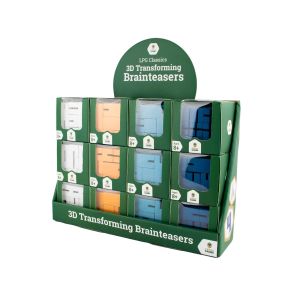Language
Curio The Lost Temple
Availability: Back-Order Item #: 199199
NZD $74.99
- Out of stock
- SKU: WZK73288 Manufacturer SKU
- RRP: NZD $74.99 Recommended Retail Price
- Barcode: 634482732885 Product barcode
A sinkhole formed west of the Tigris river in the heart of Mesopotamia, revealing a large stone door with curious, unknown markings. A special team of archaeologists, from all over the world, ventured to the site to solve its puzzle, allowing them inside. Therein, a massive man-made cavern, stretching for what seemed to be a mile straight down, could be seen. But just as the team decided to leave, the door slammed shut, sand slowly started filling the room, and the team was faced with new puzzles to solve. Can they do it in time? In the real-time cooperative game Curio: The Lost Temple, players take the role of the archaeological team as they try to escape the Lost Temple. To do this, they need to communicate and collaborate to solve an unending slew of puzzles. Unlike other games in this genre, Curio: The Lost Temple is endlessly replayable, even by the same players. Using a unique module-based system, players manipulate, sort, rotate, and search puzzle components to arrive at a distinct answer.
A sinkhole formed west of the Tigris river in the heart of Mesopotamia, revealing a large stone door with curious, unknown markings. A special team of archaeologists, from all over the world, ventured to the site to solve its puzzle, allowing them inside. Therein, a massive man-made cavern, stretching for what seemed to be a mile straight down, could be seen. But just as the team decided to leave, the door slammed shut, sand slowly started filling the room, and the team was faced with new puzzles to solve. Can they do it in time? In the real-time cooperative game Curio: The Lost Temple, players take the role of the archaeological team as they try to escape the Lost Temple. To do this, they need to communicate and collaborate to solve an unending slew of puzzles. Unlike other games in this genre, Curio: The Lost Temple is endlessly replayable, even by the same players. Using a unique module-based system, players manipulate, sort, rotate, and search puzzle components to arrive at a distinct answer.
| Board Game Genre | Multiplayer, Cooperative, Historical, Puzzle, Real-time |
|---|---|
| Weight (kg) | 0.500000 |
| LPG Bestseller | No |
| Item Group | Board Games |
| Length (cm) | 8 |
| Width (cm) | 10 |
| Height (cm) | 8 |
| Publisher | Wizkids |
| Discontinued Product | No |
| Is Expansion | No |
| Exclusive to LPG | No |
| Available for Resale | Yes |
| Dangerous Good | No |
| Allow Export | Yes |
| Core Products | Core Products Expanded |

 AU
AU





